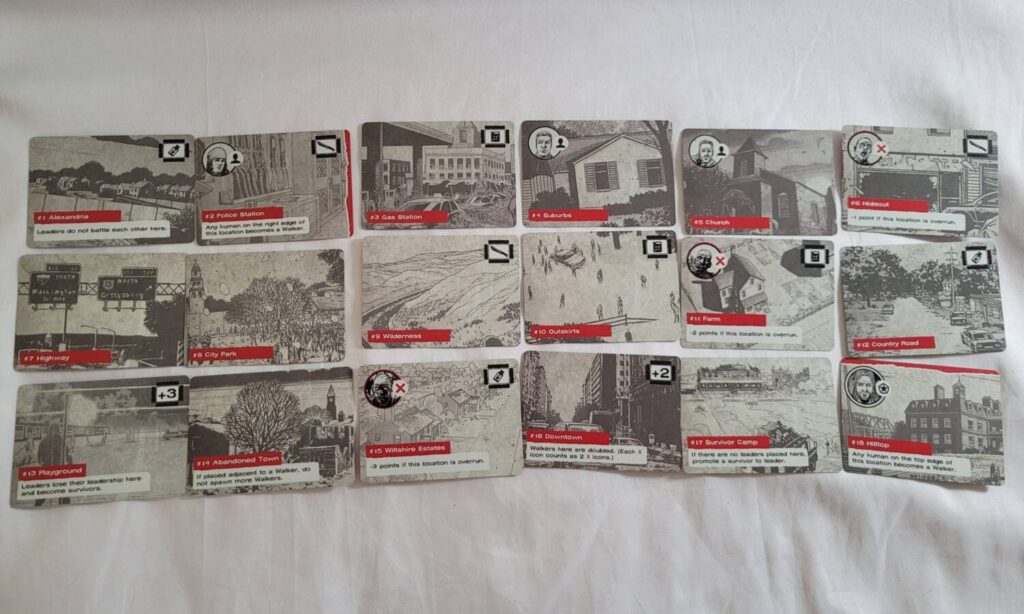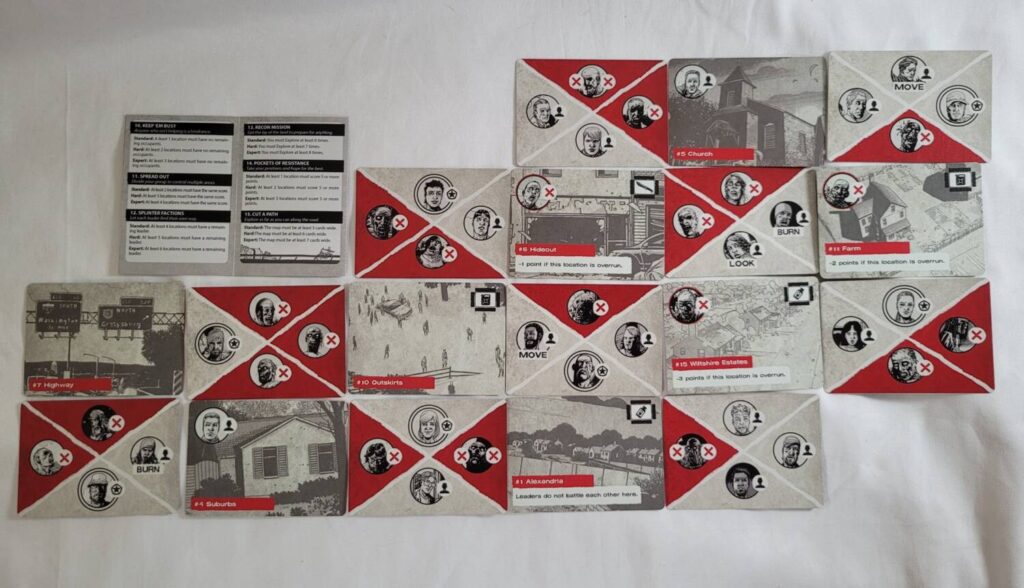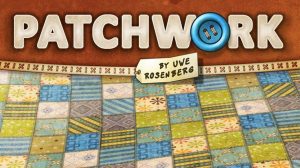Disclosure: Meeple Mountain received a free copy of this product in exchange for an honest, unbiased review. This review is not intended to be an endorsement.
If there’s one thread that runs throughout every zombie apocalypse story that’s ever been told, it’s this: without community, those that are left are doomed.
Nothing out there explores this theme quite like the worldwide sensation The Walking Dead (TWD). For the most part, the world of TWD follows a single group of Survivors, led by Rick Grimes, as they try to find their way in a world that’s hardly recognizable. And, while it initially seems the thing to fear is the titular walking dead, they soon discover that the real terror is other people.

TWD first arrived on the scene as a comic book in 2003. Written by Robert Kirkman, the series’ themes and rabid fan base eventually attracted the attention of the AMC television network who turned it into one of the most popular shows in the history of television. It ran for a total of eleven seasons over a period of twelve years and has spawned a number of spinoff series. While the core television show, and the comic books, have come to an end, it’s clear that The Walking Dead isn’t going anywhere.
From low effort tie-ins such as TWD Monopoly and TWD Jenga to more nuanced efforts such as TWD: Something to Fear, it shouldn’t come as any shock that TWD has also spawned quite a few tabletop spin offs as well. Each has asked the question: what is it possible to do with this IP in an analog format? Some have pushed the envelope further than others in their quest for an answer. In The Walking Dead: Surrounded (one to four players), Buttonshy Games not only asks what can be done with this IP in an analog format, but it asks, what can be done with this IP in an analog format using only 18 cards.
The answer is, surprisingly, quite a lot.
The Cards
TWD: Surrounded comes packaged inside of a bi-fold wallet that contains 18 cards, a rules sheet, and a scenario book. The copy that I received also contains a small expansion called TWD: Surrounded – Under Siege. Each card is double-sided. On one side of the card is a Location. On the other are four different Occupants.

There are 18 Locations in total. Each has a name and a number associated with it. Some Locations feature additional text describing some special aspect of the Location, whether it be beneficial or detrimental. For instance, one Location in the game reads: “Leaders do not battle each other here” (beneficial) and another reads “-3 points if this location is overrun” (detrimental). Some Locations come pre-populated with Occupants. Some include an icon in the upper right-hand corner (important during scoring and some scenarios). Some include a mixture of some or all of these.
On the reverse are pictured four Occupants, one for each edge of the card. Some of these Occupants are Walkers (the zombies in the TWD vernacular) and others are Human. The Humans are subdivided into two potential types: Survivors and Leaders. Each of these Occupants brings influence to bear during the scoring of a Location at the end of the game. Of the Humans, some provide extra benefits in the form of some potentially very useful abilities.
Move allows you to shift Occupants from one edge of a Location of which it is adjacent to another edge of the same Location. Look allows you to peek at both sides of an upcoming card (either the top or bottom card of the deck). Burn allows you to return a card from play (called ‘the map’ in game terminology) to the top or bottom of the deck.
The Options
The rules of the game are very easy to parse and understand. On your turn, you may either Explore or Occupy. To explore, you place the top card of the deck adjacent to at least one Occupant card in play. During setup, you will have already placed one Location card and then immediately flipped over the next card to its Occupant side and attached it to the Location in such a way that there is already one Walker in that Location. So, at the start of the game, there will be at least one Occupant card to accommodate your explore action. However, unless there is an open Occupant to attach the Location to, then your only option is the second one: Occupy.
Regardless, immediately after placing your Location, you must then occupy it with a Walker, if possible. If not possible, then attach the Walker to a Location that is able to accommodate it. If even that is impossible, discard it. Your game is over, and you can proceed to scoring.
Some Locations have Walkers pre-printed on them. If one of these is on top of your deck at the beginning of your turn, you may not occupy. You have no choice but to explore.
The Repercussions
Once you have played out all eighteen cards from the deck, the game comes to an end and scoring is performed. At each location, there is a battle. First, the Humans and the Walkers battle it out. For each Walker at a location, one Human is eliminated. If all of the Humans are eliminated, and at least one Walker remains, then the Location is considered to be overrun.
If there are two or more leaders remaining at a Location after the battle, then they will eliminate one another (unless the Location states otherwise). Then, score the remaining Occupants—Walkers and Humans alike. Each Leader scores one point for themselves as well as a point for each Survivor. Each Survivor scores a point. Each leftover Walker is worth a negative point.

Furthermore, as mentioned previously, some Locations have icons printed on them in the upper-right hand corner. If these Locations are surrounded (regardless of whether or not they were overrun), then you score the points listed (if there are any listed), or one point per icon (if an icon is displayed instead of a value).
All of these points are then added up to see how well you did. There’s a chart at the end of the rulebook that will help you determine this, either doling out high praise, or making you feel like an incompetent imbecile.
The Scenarios
While the basic game is fine, The Walking Dead: Surrounded really opens up when you start adding in the scenarios. The scenario booklet contains a different scenario for each Location. During setup, your group can either decide which specific scenario they’d like to explore and begin with that Location turned face up, or they can simply shuffle the deck and let fate decide.

Regardless, each scenario has three levels of difficulty—standard, hard, or expert. As an example, the scenario for Location #7: Highway is titled ‘One-Stop Shop’ and it reads:
Standard: Surround at least 1 gas can location, 1 weapon location, and 1 medical kit location.
Hard: (The same text as the standard scenario with the addition of…) “and these locations must not be overrun.”
Expert: (The same text as the standard scenario with the addition of…) “and each of these locations must have at least 1 remaining leader and 1 remaining Survivor.”
As you can see, while the standard scenario is an easy, underhand soft toss, the expert level is a 100+ miles per hour pitch coming straight at your face. These expert level scenarios aren’t joking around. Having played multiple scenarios at this point, I can say they’re pretty difficult to achieve, but not impossible.
The Expansion
Since I cannot guarantee that every copy of the base game is going to come with this expansion, I’m not going to spend a lot of time going into great detail about it. The Under Siege expansion contains six new cards, a new type of Occupant with its own special scoring condition, a new type of icon, and a combination rules and scenario booklet.
While not entirely necessary, this expansion does breathe some new life into the base game if you find yourself looking for new challenges. However, I don’t think that it adds enough, or changes the base game is such a drastic way, that I’d advise going out of your way to obtain it. While it’s a fine expansion and changes the game, it isn’t ‘game changing’ (if that makes any sense).
Thoughts
I’ve played a few of the games in Buttonshy Games’s very large catalog and I’ve come to realize that they’re very hit or miss, never landing anywhere in between. Either the game is a real stinker, or it’s a hidden gem. This tends to be a theme when it comes to games whose scopes are dictated by the size of the packaging rather than the size of the packaging being dictated by the scope of the game. Trying to fit very big ideas into very small spaces is no mean feat, and I am suitably impressed each time someone attempts it, even if their attempt ultimately results in a subpar game. Normally, this fluctuation between being very enamored or extremely disappointed would prevent me from voluntarily taking on one of these games, but The Walking Dead: Surrounded had two things going for it that ultimately led to me taking the chance:
- I am a huge fan of the franchise.
- These days, I am far more likely to get a game to the table that takes up very little space and can be played very quickly than I am to get something much larger and longer (like Lisboa, for instance).
When I opened the envelope that was sent to me, I was immediately struck by the simple, yet effective packaging. Without even opening the wallet, I could tell what kind of game I was getting. The bold red lettering on the black background speaks to the desperate violence contained within. And, the font used advised me that I wasn’t going to be encountering any stills taken from the television show inside.
When it comes to TWD: Surrounded, fans of the comic books will more likely enjoy the visuals than fans of the television series. That isn’t to say that folks who have never been exposed to the comic books won’t enjoy what they see here, though. While simplistic in its design aesthetics, it’s still a very attractive game. That simplicity works in the game’s favor. The game can be taught in just a few minutes. Each piece of necessary information is imparted quickly and easily. There’s no extra fluff.
While I enjoy the base game well enough, I wouldn’t recommend playing the game more than once or twice (to get a feel for the mechanics) before adding in the scenarios. Without those, there’s no challenge. There’s no losing. There is only getting a low score.
Once the scenarios are added in, though, things get serious. There’s no understating the stress of playing an expert level scenario like Location #2: Police Station (which states that you must surround 2 weapon locations, and each must have at least 1 remaining Leader and 1 remaining Survivor) when the game forced you to add one of the three weapon Locations as an Occupant earlier and you know from a previous look action that the last weapon Location is on the bottom of the deck. When the things you need are right there on top, surrounding them is a no-brainer. But, when it’s almost mathematically impossible for you to succeed, it’s much, much more challenging. It’s going to take a lot of strategy and teamwork if you want to pull out a win.
In this way, TWD: Surrounded plunges you directly into the reality of the world The Walking Dead’s characters inhabit. The outcome looks bleak. The deck is stacked against you. You can curl up in a ball and just accept your fate, or you can reach down deep inside to find the grit to survive and thrive, and you can’t do it alone.
So, grab some friends, grab yourself a copy of this game, and get ready to fight some zombies. Just don’t let yourselves get surrounded.










